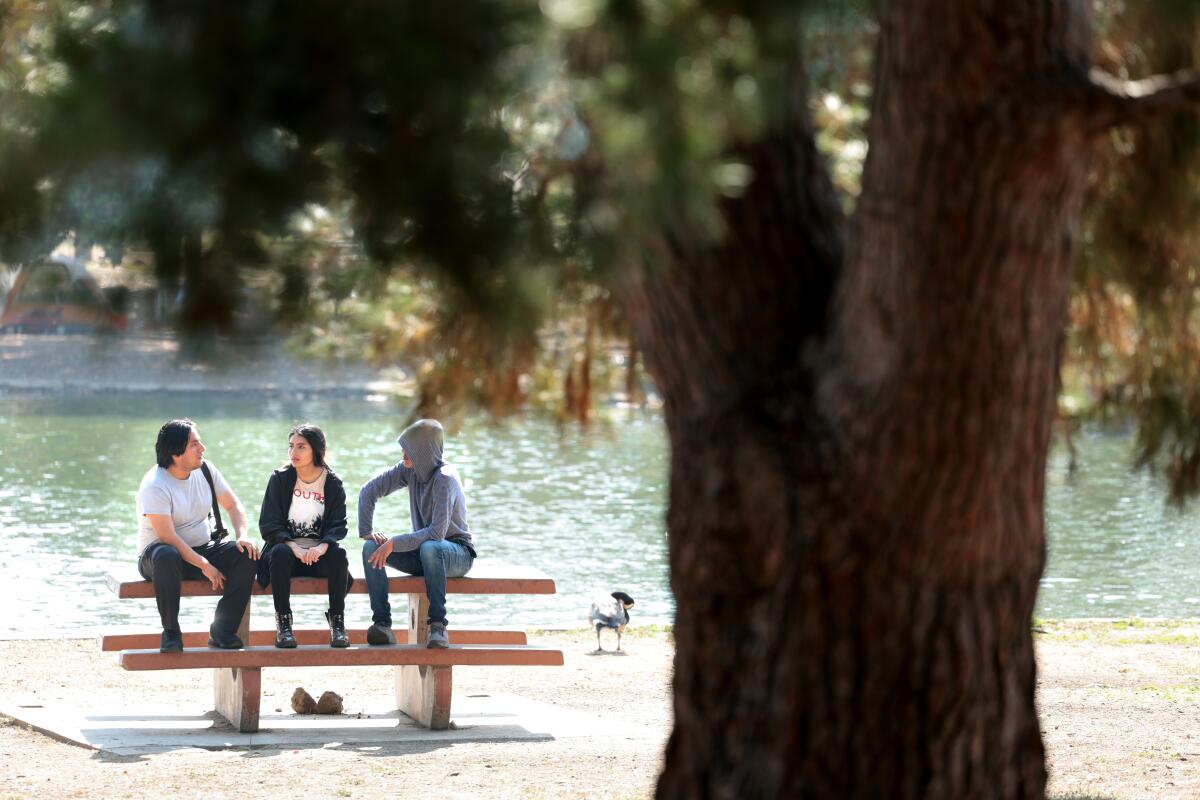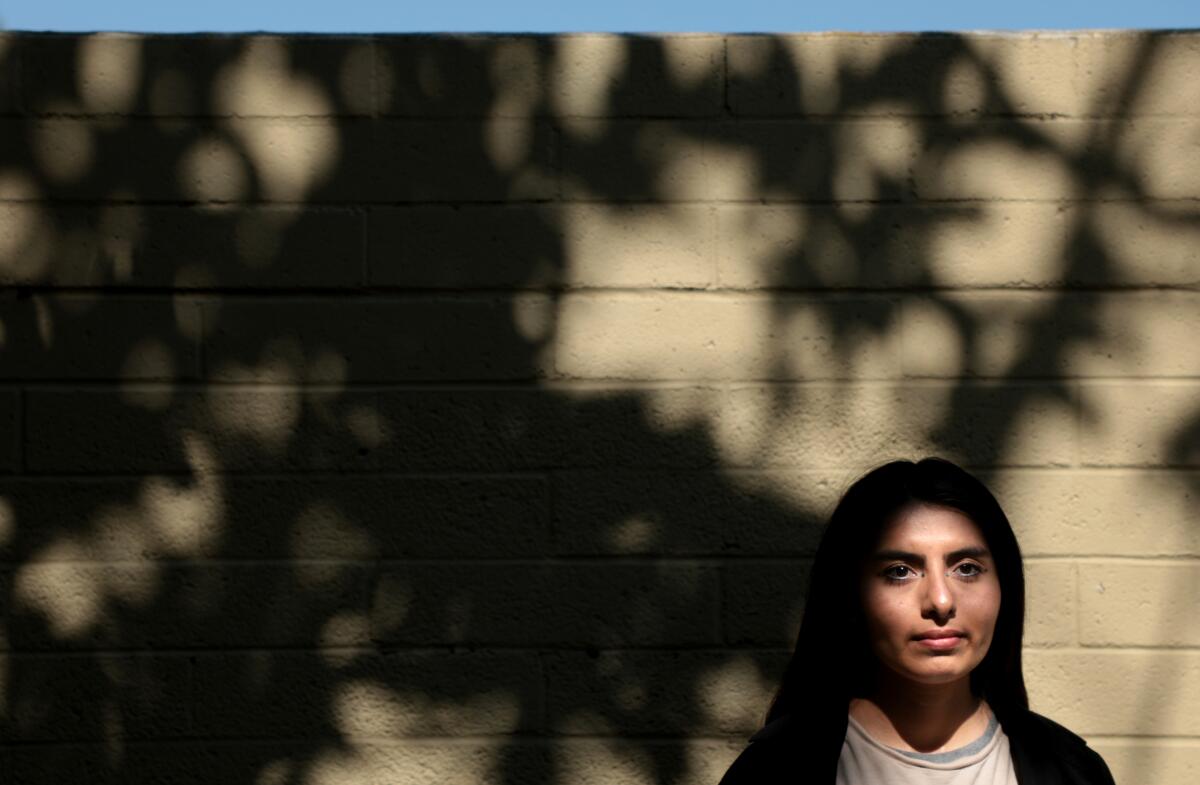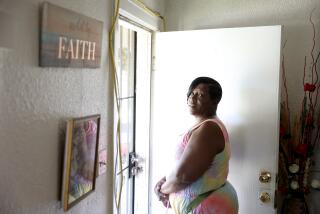How many foster kids are homeless in L.A. County? Nobody knows

- Share via
Iziko Calderon was in 10th grade when the seizures started.
A foster youth who had churned through abusive homes, Calderon assumed the episodes were a reaction to years of pent-up trauma. Calderon every so often would collapse at school, writhing from nerve pain as if engulfed in fire.
“People in school were afraid of me,” recounted Calderon, now 22 and a community organizer.
Calderon, who uses “they” pronouns, dropped out of Los Angeles High that school year, around age 16, in part because the teachers didn’t seem to know how to handle the debilitating episodes.
Two years later, shortly after turning 18, Calderon would flee another tense living situation and return to the school — not to enroll but to sleep on a park bench outside. For the next year, Calderon says, they were homeless, sleeping in their car and showering on Venice Beach, all while under the custody of the Los Angeles County Department of Children and Family Services.
Every year, teens and young adults quietly slip from foster homes to the street, even as the county remains responsible for their care. After years of county officials promising more safe and reliable placement options for older foster kids, a sprawling federal lawsuit is putting new pressure on the nation’s largest child welfare system to get it done.
In June, U.S. District Judge John Kronstadt allowed a class-action lawsuit against Los Angeles County and the state to move forward, emphasizing that the government’s responsibility to foster kids doesn’t necessarily end when they turn 18.
In California, teens can opt to stay in foster care until 21, meaning the government is responsible for keeping a roof over their heads as they navigate early adulthood. The four firms suing the state and county — Children’s Rights; Public Counsel; Munger, Tolles & Olson; and Alliance for Children’s Rights — argue that the lack of stable housing and mental health services for older foster youths has turned the promise hollow.
“We still find ourselves with far too many children living on the streets, couch-surfing, in and out of homeless shelters,” said Leecia Welch, deputy litigation director at New York-based Children’s Rights. “It is just incredibly dangerous.”

Last week, the attorneys filed an updated complaint with new details on one of their allegations: Neither the county, which runs the foster care system, nor the state, which oversees it, knows how many foster youths are living on the street.
“It is very hard to compare L.A. to other places, because they simply don’t track whether or not kids are ending up homeless,” said Welch.
Attorneys say DCFS officials told them the county doesn’t track homelessness rates among foster youths. Nor does the California Department of Social Services. The lawsuit quotes the chief deputy director of the Department of Social Services telling legislators in April that the agency “does not track data in a way that allows us to know how frequently [foster] youth experience homelessness or housing insecurity.”
There are approximately 2,500 young adults ages 18 to 21 in foster care in L.A. County. DCFS did not respond to a question from The Times about how many were homeless, emphasizing that the agency doesn’t comment on pending lawsuits.
“The county is committed to ensuring the well-being of young people as they enter adulthood and providing available services to assist with that transition,” the agency said in a statement.
The state Department of Social Services said officials there don’t comment on ongoing litigation.
The county’s most recent point-in-time homeless survey found 3,718 young people ages 18 to 24 living in temporary shelter or on the streets.
“I wouldn’t be surprised if close to half have been in our system” said Supervisor Kathryn Barger, adding that she recently met with DCFS Director Brandon Nichols about the possibility of master-leasing units for foster teens.

Soft-spoken, with jittery knees and scuffed Converse sneakers, Calderon could easily be the face of the lawsuit moving through federal court.
Like many foster youths, Calderon recalls a childhood punctuated by violence. In Calderon’s recounting, DCFS took them from their parents as a baby after allegations of abuse in the home. A string of fraught placements followed, including a period where Calderon was given back to their father, who they say once stabbed them with a fork when they wouldn’t eat. As a teenager, Calderon said, the father took them to his home country of Peru, taunting that there was no child welfare agency to save them.
At 15, Calderon made it back to the U.S. alone. The seizures started soon after. After a bad one at school on the way out of PE, Calderon said they landed in a mental hospital and back on the radar of DCFS.
At the time, Calderon was living with an older sister near school. But tensions mounted, with the seizures making Calderon feel like a wrecking ball in the sister’s stable life. Calderon asked their social worker to find a new placement.
There are two main housing options available to older foster youths. The county either provides a stipend they can use to find a place on the open market or provides free supervised housing, often with a suite of services meant to launch them into adulthood: counseling, employment help, budgeting tips.
Calderon said the social worker submitted two applications for supportive housing that went nowhere before Calderon left for the park bench.
“She was panicked,” Calderon said. “I would always [ask] her, is there anything out there for me? It’s the most heartbreaking part where you want help, and your caseworker is like, ‘I don’t know.’”
The wait for supportive housing, considered something of a holy grail for older foster youth, can drag on for months. And foster kids struggle on the rental market with no rental history, no guarantor and a monthly stipend of a little over $1,200.
Calderon, who received stipends while homeless, says they submitted two applications for studio apartments that were denied.
Without enough foster housing, the county at times has rented hotel rooms for older foster youths, often with minimal supervision. An investigation published last year, jointly reported by The Times and the Investigative Reporting Program at UC Berkeley, found that the county placed hundreds of foster kids in hotel rooms between January 2022 and May 2023, some of them young people in dire need of mental health care.
Two alleged assaults on Los Angeles County social workers by foster children have sparked criticism that such violence was inevitable.
In February, the state ordered the county to “immediately cease” the hotel placements, noting that such sites are not licensed to shelter foster youth.
DCFS told The Times it no longer uses hotels for temporary housing.
Michael Nash, a former presiding judge of Los Angeles County’s Juvenile Court, says he believes the county needs to focus on finding nurturing, stable placements for foster kids — ideally families — before they hit 18. After that, he says, there will “never be enough” housing to help them all.
“You’ve got thousands of kids who are potentially going to age out of our system,” he says. “What does that mean for our homeless population? Nothing good.”
More to Read
Sign up for Essential California
The most important California stories and recommendations in your inbox every morning.
You may occasionally receive promotional content from the Los Angeles Times.











